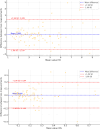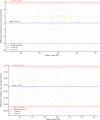Reproducibility of quantitative cervical strain elastography in nonpregnant patients and the effect of vaginal misoprostol on measured parameters
- PMID: 40374741
- PMCID: PMC12081600
- DOI: 10.1038/s41598-025-01249-y
Reproducibility of quantitative cervical strain elastography in nonpregnant patients and the effect of vaginal misoprostol on measured parameters
Abstract
Quantitative strain elastography (SE), referred to as E-Cervix (Samsung Medison), is a novel method for assessing parameters that indirectly describe the elasticity of the cervix. This evaluation yields quantitative parameters based on the analysis of the elastographic map image, which represents a new approach in the context of SE. In our study, we aimed to examine the reproducibility of this method in evaluating the cervix of non-pregnant women, the impact of basic demographic parameters of the patient on the results, and the responsiveness of the method, i.e., the assessment of changes occurring in the results after the vaginal application of a 400 µg dose of misoprostol. We included 80 patients scheduled for hysteroscopy who underwent elastographic examination using the E-Cervix module. The examination was performed twice upon admission to the department by the same ultrasonographer and then again 10-12 h after vaginal application of misoprostol, consecutively by two ultrasonographers. Our study demonstrated high reproducibility of all obtained parameters, with ICC (Intraclass Correlation Coefficient) for intraobserver variability being good to excellent, ranging from 0.85 for ECI (Elasticity index) to 0.94 for IOS (Internal Os strain)/EOS (External Os strain) ratio. For interobserver variability, ICC values ranged from 0.76 for ECI to 0.97 for IOS/EOS ratio. We observed no significant correlation between parameters such as height, weight, BMI (body mass index), and the number of births in the patient's history and the values of elastographic parameters. We found weak to moderate positive correlations between the day of the cycle in which the patient was and ECI (rho = 0.28), EOS (rho = 0.41), IOS/EOS ratio (rho = 0.33). The study observed a significant increase in the median value of the HR (Hardness ratio) parameter after the application of vaginal misoprostol (median difference = 5.32), an increase in EOS (difference of the medians = 0.04), and a significant decrease in IOS/EOS ratio (difference of medians = - 0.05). In our study, we demonstrated high reproducibility and repeatability of E-Cervix parameters in non-pregnant women and showed a negligible influence of most demographic factors on the study outcomes, as well as changes in parameter values under the influence of drugs affecting cervical elasticity. The method appears to be suitable for evaluating the cervix in non-pregnant women.
© 2025. The Author(s).
Conflict of interest statement
Competing interests: The authors declare no competing interests.
Figures






Similar articles
-
Repeatability and reproducibility of quantitative cervical strain elastography (E-Cervix) in pregnancy.Sci Rep. 2021 Dec 8;11(1):23689. doi: 10.1038/s41598-021-02498-3. Sci Rep. 2021. PMID: 34880263 Free PMC article.
-
Cervical elastography in predicting spontaneous preterm birth in singleton pregnancy with a short cervix receiving progesterone treatment at 18 to 24 weeks' gestation.J Matern Fetal Neonatal Med. 2024 Dec;37(1):2347954. doi: 10.1080/14767058.2024.2347954. Epub 2024 May 7. J Matern Fetal Neonatal Med. 2024. PMID: 38714523
-
Quantitative cervical elastography: a new approach of cervical insufficiency prediction.Arch Gynecol Obstet. 2020 Jan;301(1):207-215. doi: 10.1007/s00404-019-05377-5. Epub 2019 Nov 22. Arch Gynecol Obstet. 2020. PMID: 31758303
-
[Cervical ripening using misoprostol before hysteroscopy].Gynecol Obstet Fertil. 2006 Jan;34(1):49-53. doi: 10.1016/j.gyobfe.2005.11.004. Epub 2006 Jan 18. Gynecol Obstet Fertil. 2006. PMID: 16413811 Review. French.
-
Cervical priming with misoprostol prior to transcervical procedures.Int J Gynaecol Obstet. 2007 Dec;99 Suppl 2:S168-71. doi: 10.1016/j.ijgo.2007.09.005. Epub 2007 Oct 24. Int J Gynaecol Obstet. 2007. PMID: 17961571 Review.
References
-
- Swiatkowska-Feund, M., Traczyk-Łoś, A., Preis, K., Łukaszuk, M. & Zielińska, K. Prognostic value of elastography in predicting premature delivery. Ginekol. Pol.85, 204–207 (2014). - PubMed
-
- Samsung Medison, R. D. E-Cervix: A tool for measuring the stiffness of the cervix using elastographic images (2018). https://www.samsungmedison.com.
MeSH terms
Substances
LinkOut - more resources
Full Text Sources
Medical

